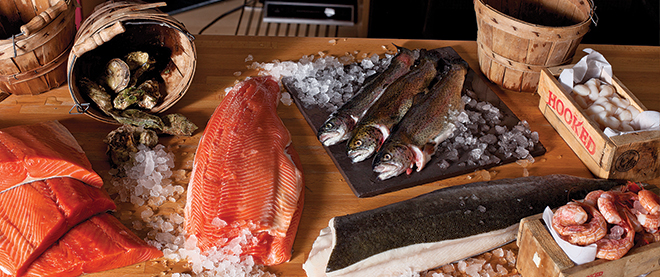Is Ocean Wise fish also palate-foolish?
Take that list of sustainable seafood with a grain of salt, or a pat of butter – flavour still matters
Photograph by Liam Mogan
Share
Imagine this: a 12-piece sashimi lunch special, featuring a couple of slices each of sockeye and Chinook salmon, some albacore tuna, a touch of sad, stringy and browning Yellowfin tuna, and something muddy that may have been farmed striped bass, or maybe not. No shellfish, no molluscs, no octopus, no tamago-yaki—not even any firm, fatty and lightly vinegared mackerel. For a cuisine wherein texture and mouth feel is paramount, here was an offering so texturally monotonous as to offer nothing but cold, damp, soft fish.
In other words, just another downtown lunch special, cranked out by a mercenary Asian line-cook for the hordes of gaijin who don’t know any better, right? Not quite. This could be the future of sushi, if you unconditionally hand over the keys to the kitchen to a conservationist organization like, say, Ocean Wise. For the sushi restaurant in question (Toronto’s Just Sushi) is the first of its kind to operate in 100 per cent compliance with the recommendations of menu-appropriate fish published by that conservation arm of the Vancouver Aquarium.
The media response to Just Sushi has thus far been rapturous—which just goes to show that, when it comes to our sadly depleted oceans, just about every enlightened consumer is increasingly desperate to do the right thing. Organizations like Ocean Wise—and San Francisco’s Seafood Watch, the conservation arm of the Monterey Aquarium, which inspired it—make this a lot easier. But they do not make it easy, at least for people who care about what they eat, not just because of where it comes from, but how it tastes. On that front, the Ocean Wise list of recommended fish can be rather distressing.
Many of the recommended fish are in good supply for a good reason. I mean, how many times a week do you really want to eat horse mackerel? Or sea smelt? Or farmed catfish? Is there anyone who actually prefers bland, soft Greenland turbot to its deliciously firm—albeit lamentably scarce—brethren from the North Sea? Or would more happily dine on chum or pink salmon than a wild salmo salar hooked on a fly on the Spey?
Well, no. But, happily, there are some good choices on the recommended list, too. The single best commercially available piece of fish I ate last year comes as highly recommended by Ocean Wise as any fish can be: It was sturgeon, farmed inland, at a organic-certified farm on the Sunshine Coast of B.C. called Target Marine Hatcheries.
The fish bakes beautifully. It is nearly as firm as monkfish, but with a luscious fat content. It works perfectly with a simple, buttery sauce. Target ships it fresh across the country. If your fishmonger does not carry it, ask him to. But you may not have to; because of increasingly prevalent caviar farming, its by-product, sturgeon flesh, is increasingly easy to find. Hooked, a sustainable-fishery-focused shop in Toronto, often carries fresh sturgeon farmed stateside. If you have yet to try it, do so.
And there are many other such fish that don’t get their proper due on local menus. Ocean Wise and chefs alike recommend farmed barramundi, Lake Erie pickerel, farmed steelhead, and wild American striped bass and pompano. Alaskan black cod stocks are still going strong, if caught the right way (bottom longline or trap) in the right waters (off B.C. or Alaska). Likewise ling cod. But of these two usually splendid eating fish, try not to be put off if you get a mushy one. Both suffer from this proclivity, and it cannot be identified until cooked.
The most important thing in the new, diminished world of shopping for fish is to never be dogmatic. Ocean Wise recommendations are good to try—but remember that most are based on fishing method and provenance as much as general health of stocks. Your fishmonger lies to you about whether or not your fish was frozen. Why trust him on whether it was caught in a net or on a line? Remember this next time you find yourself guiltily eyeing a great-looking endangered skate wing—and grab it. It is already deceased, after all. The least you can do is cook it properly, and embalm it in a good beurre noisette.
